The Conservation Column
By Pepper Trail
As I discussed in last month’s column, the arrival of a new administration in Washington means that conservation organizations can hope to advance an ambitious forward-looking agenda, rather than simply attempt to defend the victories of the past. Recently, the National Audubon Society and the American Bird Conservancy released the outlines of such an ambitious agenda, called “Bring Back Birds.” Below, I provide an excerpt from the full article, which can be seen by cutting and pasting the link below into your browser.
https://abcbirds.org/wp-content/uploads/2021/03/BringBirdsBackPolicies.pdf?eType=EmailBlastContent&eId=a5ea61da-08fa-434f-b092-92fe410fb3d1
Bring Back Birds
The landmark study, “Decline of the North American Avifauna,” published in 2019 in the journal Science, found that bird populations have declined by close to 3 billion birds since 1970, representing a 29% overall decline in 50 years. There are many historical and current causes of declining bird populations, including habitat loss, direct mortality due to industrial hazards, predation by cats, building collisions, and invasive species. In addition, a recent Audubon report found that two-thirds of North America’s birds are gravely threatened by climate change.
There is urgent need to address these and other threats so as to avert continued catastrophic declines. Fortunately, the remarkable recovery of waterfowl populations, sustained now for decades, to say nothing of the endangered bird species returned from the brink of extinction, demonstrate that coordinated, sustained conservation action works.
Just as there is no single cause of declining migratory bird populations, there is no single policy solution, program or approach that will suffice. Instead, we need a suite of actions that foster on-the-ground protection, mitigation, and restoration of bird populations and the habitats they need to thrive. Audubon and the American Bird Conservancy have identified the following policy options to be considered by Congress and the Administration in 2021 and beyond. We welcome comments and suggestions on these ideas and we invite other organizations to endorse these concepts in principle, recognizing that these are not detailed proposals.
Planning, Research and Evaluation
Reauthorize and amend the Fish and Wildlife Conservation Act to provide additional direction for migratory bird conservation:
• Support national, regional, and flyway bird conservation planning and implementation
• Revitalize and enhance the Migratory Bird Data Center to support integrated assessments of bird populations by federal, state, and private partners
• Identify and report to Congress on lands and waters needed to conserve migratory birds, including in the Western Hemisphere and the East Asian-Australasian and Oceana flyway
• Evaluate implementation of international authorities and programs and develop a federal strategy and recommendations for international migratory bird conservation
Engagement and Partnerships
Support Migratory Bird Joint Ventures and enhance project delivery and the ability to address the needs of all birds and all habitats:
• Increase annual funding to assure base staffing and support are ample and equitable for all Joint Ventures
Support the Urban Bird Treaty Program and authorize increased funding:
• Increase staff capacity and funding for partner grants
Support voluntary, community-based conservation on private working lands across the country in cooperation with Joint Ventures and other partners:
• Increase funding for the Partners for Fish and Wildlife Program
Addressing Threats
Reaffirm that the Migratory Bird Treaty Act covers incidental taking, and establish a permit program to apply available best management practices that reduce bird mortality:
• Pass the Migratory Bird Protection Act and develop a permitting rule through the U.S. Fish and Wildlife Service
Facilitate and demonstrate bird-friendly practices in the construction of federal buildings:
• Pass the Bird-Safe Buildings Act
Enhance and demonstrate U.S. leadership in reducing fisheries bycatch of marine birds:
• Ratify and enact implementing legislation for the Agreement on the Conservation of Albatrosses and Petrels
Ensure there are coordinated and consistent approaches toward federal planning and actions that impact migratory birds:
• Revitalize Executive Order 13186 on the Responsibilities to Protect Migratory Birds
• Require consideration of climate change in federal planning related to birds
Policy and Funding
Elevate the Neotropical Migratory Bird Conservation Act (NMBCA) so that it can help address the needs of these declining species:
• Increase funding for grants
• Change the federal to private matching ratio from 1:3 to 1:1 to facilitate greater participation, particularly among Central and South American and Caribbean conservation groups
Pass the Recovering America’s Wildlife Act to boost conservation of migratory birds and other wildlife by state wildlife agencies:
• Include mandatory spending outside of the annual appropriations cycle
Establish a new “Songbird Stamp” as a sister program for the federal Migratory Bird Hunting and Conservation Stamp (aka Duck Stamp) to raise funds for bird conservation:
• Use net revenue to support conservation efforts such as NMBCA grants or other relevant programs
Land and Water Conservation
Develop new landscape-scale habitat initiatives on par with NAWCA:
• Conserving North American grasslands is a current priority, and other initiatives could include a focus on ecosystems such as the sage-steppe, saline lakes, and old-growth forests in Alaska and the Pacific Northwest
Taking Action Close to Home
RVAS takes action almost every month to advocate for the protection of birds locally and across Oregon, as well as nationwide. In case you missed it, please visit https://mailtribune.com/opinion/guest-opinions/snags-have-value-as-essential-homes-for-wildlife to review a March 7 op-ed that I co-wrote with Lyndia Hammer of the Southern Oregon Land Conservancy advocating for the preservation of snags for wildlife, especially in the areas of the Bear Creek Greenway burned by the Almeda Fire. Board member Jon Deason has been particularly involved in this effort.
On a more regional issue, RVAS recently sent a letter to the US Fish and Wildlife Service (see below) protesting a rule adopted in the last days of the prior administration that would remove almost 3.5 million acres from critical habitat protection for the Northern Spotted Owl. Through these and other actions, Rogue Valley Audubon continually works to assure that we will always have birds to watch, and habitat for them to call home.
US Fish and Wildlife Service
Re: Docket FWS-R1-ES-2020-0050
I am writing on behalf of the Rogue Valley Audubon Society (RVAS), a chapter of the National Audubon Society with over 500 members in southern Oregon. Our chapter has long advocated for strong protections for the Northern Spotted Owl, an emblematic bird of our Pacific Northwest old-growth forests. RVAS applauds the U.S. Fish and Wildlife Service extension of the effective date for the proposed Northern Spotted Owl critical habitat rule. This is necessary to give the Service time to evaluate this rule from the previous administration and ensure it does not go into effect. That “final rule” drastically scaled back critical habitat protections for the threatened Northern Spotted Owl. It was published in the Federal Register on January 15, 2021 and was clearly a last minute attempt by the outgoing administration to weaken protections for old-growth forests.
We support the U.S. Fish and Wildlife Service following sound science – and the requirements of the Endangered Species Act – by eliminating the 2021 rule as quickly as possible. There is no scientific justification to remove any critical habitat for the Northern Spotted Owl, whose populations continue to decline. The rule, if allowed to go into effect, would remove 3.5 million acres from critical habitat designation, a massive area of Pacific Northwest ancient forest ecosystems. These are the exact forests that Service biologists deemed critical to the recovery of the threatened bird.
We support protections of Northern Spotted Owl critical habitat because the owl and our Pacific Northwest forest ecosystems are critical to our future. The science is clear, old-growth forests are essential for the Northern Spotted Owl and a host of other forest species. Old forests with big trees provide important ecosystem services as well; they produce cleaner water and are massive stores of carbon that help fight climate change. Finally, these are the cherished places we hike, birdwatch, and find the peace and solace of nature.
We need to save our remaining ancient forests and the Northern Spotted Owl, not weaken protections for them.
Sincerely,
Carol Mockridge
President, Rogue Valley Audubon Society



Leave A Comment
You must be logged in to post a comment.